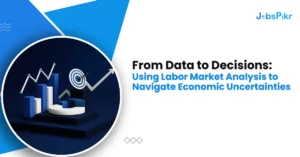There isn’t a ‘been in business for 4784 years’ stamp in brand stories anymore. There is a ‘survived Covid’ stamp. It is the new Before Christ and Anno Domini. The pandemic has had changes so profound that we charter a new course in every aspect of our lives. Especially our professional lives. The future of jobs looks different in the post COVID world.
Jobs have become outdated overnight in the wake of 2020, and new slots have opened up to help the economy recover. Wondering where to start and where to redirect your energies? We got you. We will understand how the new economic trends are translated into specific roles and industries, and skills – all of it.
The economic vitality this symbolizes is super exciting but will also bring about a seismic labor market shift. What defines prosperity and the jobs of the future before will be completely upended. But it is not all bad news.
In this blog, we aim to help reduce the significant disparity between the current workforce and the workforce needed decades ahead.
The Year That Was
The most significant blow that was absorbed was to the workforce industry. In moments of astute crisis in May 2020, job listings were down by half compared to the same period in 2019. Even when the economy opened up, and there was weak light at the end of the tunnel, in December 2020, job listings were down by 39% compared to 2019 levels.
Pandemics and disasters of this scale force society to restart: there is no choice in the matter. But this time around, they restart with caution.
The Future is Not Bleak
Think of it as a regular business cycle. The economy will correct itself. We will crawl out of the recession valley to hit newer peaks. Training investments will play a massive role in how the workforce can be prepared for a future of this scale. The future-readiness is a function of how the education sector reacts to this unprecedented shift and how the current companies do.
On a positive note, it has been estimated that a range of 15.5 million to 18 million new jobs will be created over the next half a decade which will drive recovery. Upskilling and reskilling will be at the very center of this shift more than the very nature of the job itself. Research on job postings has shown the core skills required in ‘regular’ jobs have changed up to a whopping 40% over the past decade: brought about purely by the influx of newer technologies every day. Jobs have been reshaped beyond our wildest imagination. If you look over the past decade, the relative shifts in skill demand become apparent as to how emerging technologies recast the economy. Only the pace at which it will now change will be more so than ever!
We have identified and listed five mutually exclusive fields that will shape and drive this economic recovery.
Fields that Will Drive this Economic Recovery – Future of Jobs
The Readiness Economy
This is society’s mouthguard against vulnerabilities that uncertainty brings about. These are the frontliners. The providers of social resilience: healthcare, social security, banking, insurance, and the like. This is what empowers society when you are hitting the valleys of the business cycle.
The Logistics Economy
This is what aids the entire chain of demand, manufacturing, and supply. Even if the manufacturing units keep up with the demand, the supply chain fails, and the economy gets stuck in a loop and hits peaks of inflation, with the ever-widening demand-supply gap. Remember how the nation went into a tizzy over toilet papers in the summer of 2020?
Creating intermodal supply chains which are entirely too automated and reliable will be the key to remodel this economy. Besides new and upcoming demand at scale for advanced logistics skills, there will likely also be a domino effect in the supporting manufacturing sector. The Internet of Things will play a significant role in making it as robust as possible at every level.
The Green Economy
Electric vehicles. Plastic alternatives. Climate change initiatives.
Sounds all too familiar? That is because this is the real future. This is where we aim to be. This is where we have to be. With the new government in place, the nation’s interests are shifting rapidly towards products and services aligned with environmental policies. If there is one macro industry to watch out for, it is this one about time at that. A staggering seventy percent of the new electricity generation expected in 2021 is predicted to come from solar and wind power. The future of jobs is expected to be extremely different.
The Remote Economy
We have reiterated this in the past. And we will repeat this. Work from anywhere is the new normal. The positives far outweigh the negatives. Automation will only drive it up further. Employers are happy with this; employees are happy with this, the planet is happy with this since the overall carbon footprint is dropping. It is a win-win-win! The growing interdependence on the software industry is the critical underpinning of the work from the home economy. Niche specializations in cloud computing and network systems are the main drivers here. Artificial and virtual reality will also play a more prominent role in providing a wholesome experience to both stakeholders.
The Automated Economy
This industry will aid every other industry listed above. Artificial Intelligence and Machine Learning won’t just be fancy phrases reserved for articles and the board room. It will take over every aspect of our lives. Automation will thrive. It is the only road to the future.
The Future of Jobs Through the Lens of These Industries
While these are the broad categories that will thrive in times to come, none of them are new. By any standards.
Even before the pandemic hit, these five economies comprised nearly a whopping 5 million jobs in total, an increase by 48% over the past five years. That’s almost assumed to align with the increase in job openings and, therefore, job postings across the entire economy.
Not all of these five economies can be expected to grow at the same rate, either. Roles in the automated economy rose by about 19% year on year, while the logistics economy grew only by roughly 3% annually.
Whatever the case might be, job boards might want to start taking notes on how and when they can and should leverage this data. The future of jobs will be extremely different. They can create subcategories and dedicate sections to these economies separately. They can chalk out advertising budgets and spaces for these key skills. More so than ever, they can start scraping job listings that come under these economies.




